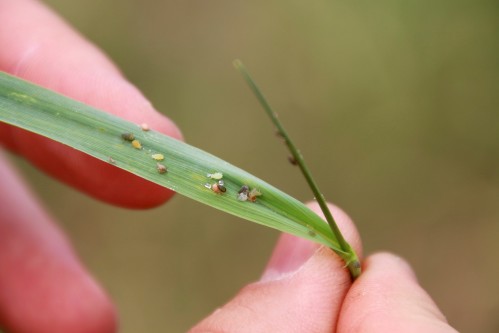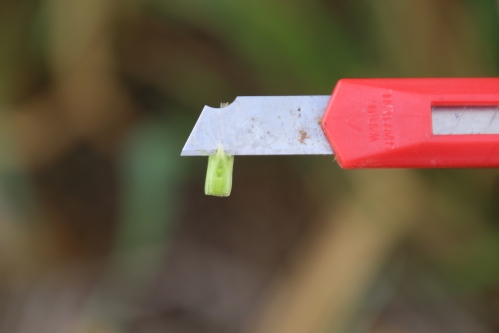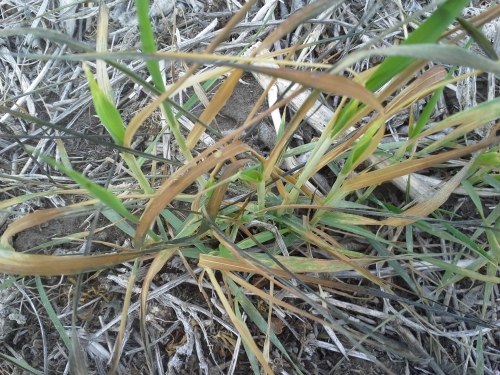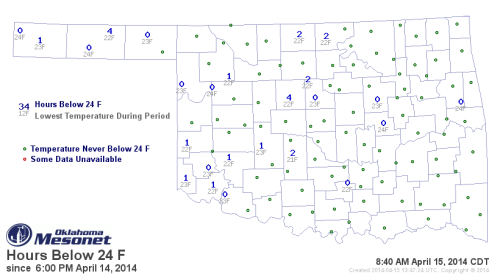Amanda de Oliveira Silva, Small Grains Extension Specialist
Temperatures dropped below freezing in the past hours in northwestern Oklahoma and Panhandle (Figures 1 and 2), and freezing temperatures are expected across most of the state tomorrow morning (April 21) (Figure 3). There is a potential for freeze injury to Oklahoma wheat. The extent of that will depend on several factors, including the growth stage of the plants, how low the temperature will get, and how long it stays at those cold temperatures.



What are the temperatures that can damage the wheat plants?
This will depend on the growth stage of the plants. Anecdotal evidence suggests varietal differences in resistance to spring freeze injury, but this is likely due to differences in plant growth stages when the freeze event occurred. Earlier maturing varieties are more likely to be injured from these recent freeze events than later maturing varieties because they are likely more advanced. The susceptibility of wheat plants to freeze injury steadily increases as we progress through the spring from jointing to heading and flowering. Figure 4 below is a general guide to the minimum temperature threshold and its impact on yield. Keep in mind these temperature thresholds are not exact but provide a decent rule of thumb. Temperatures closer to the soil surface might be higher than those reported by weather stations one meter above the soil surface, especially if moisture is present. It is difficult to have exact numbers because each freeze event is unique. While a field at the jointing stage could spend two hours at 24 F, it is possible that the same amount of injury could occur at a 28 F temperature that was sustained for a more extended period.

How long should I wait to assess the injury?
Another important thing to keep in mind is that we need to be patient before assessing freeze injury. The extent of a significant freeze event may not be apparent 1 or 2 days after. If warm temperatures return quickly, you should wait about 5-7 days before determining the injury. Suppose temperatures remain cool after the freeze event. In that case, it may take 10-14 days before the extent of the injury can be fully assessed.
What are some freeze injury symptoms to look for?
A typical freeze injury symptom is leaf tips turning yellow and necrotic (Figure 5). This is very often just cosmetic and will not hurt yield in the end. More severe damage can result in the entire leaf turning yellow to white, and the plants become flaccid (Figure 6). You may even notice a “silage” smell after several days.


The most important plant part to check is the developing head (i.e., growing point)
This will be important for areas of the state with fields with plants at flag leaf emergence stage. Sometimes we can see what look like healthy plants overall, but the developing head has been damaged or killed. To get a look at the developing head, you can slice the stem open lengthways. A healthy growing point will have a crisp, whitish-green appearance and be turgid (Figure 7). Often, you can lightly flick the head, and if it bounces back and does not break, it is still healthy. If it is mushy, limp, and breaks or parts of it break off when you lightly flick it, it has been compromised. It may also have a brown color (Figure 8, right). Another indication that the growing point has been compromised is that the next emerging leaf is necrotic, and the lower stems are discolored, with lesions and enlarged nodes.


Freezing at the boot stage may cause the head to be trapped by the sheaths of the flag leaf resulting in issues with head emergence (Figure 9). The whitish tips of the awns indicate that it was exposed to freezing temperatures and that the flower parts could have been compromised. Freeze during the flowering stage may result in flower sterility via the death of the anthers (male organ) and consequently poor kernel set and grain yield losses (Figure 10).
Also, the percent of damaged heads may not translate into percent yield loss. For example, there is still an opportunity for wheat to produce additional tillers and/or retain secondary tillers at the jointing stage. Whether or not these tillers can compensate for larger tillers that were lost due to freeze will depend on the subsequent weather. If conditions are favorable, there is a chance for late-emerging tillers to have a shot at producing grain. If the wheat is more advanced (which is the case for most Oklahoma wheat), it will be more challenging to make this type of recovery.


A few points to consider:
Every freeze event is unique and freeze injury needs to be checked on a field by field basis – the temperatures and time durations we use regarding freeze injury are rules of thumb and are not exact. I have seen instances where conventional wisdom would indicate complete crop loss, and we skate through with minimal damage.
The amount of injury observed will depend on – the growth stage of the plants, how low the temperature got, and how long it stayed at those cold temperatures. Other factors such as elevation, residue cover, and moisture can influence the observed temperature within the canopy as well. Because of the number of influential factors, it is important to check each field. It is possible to have variability in injury symptoms among fields and even within fields.
It will take a few days to see how bad things are – Symptoms may start to appear mid-next week and will likely be identifiable by the end of the following week. Healthy wheat heads will remain turgid with a green color. Damaged wheat heads will be bleached, yellow, or brown and will easily break when pushed against.
Additional Resources
Contact your local Extension office.






































